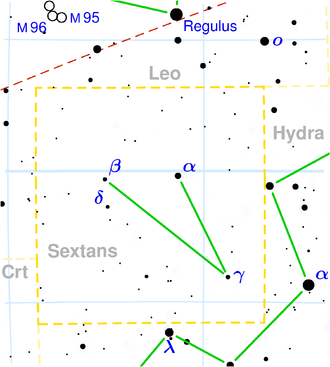NGC 2980
| Galaxie NGC 2980 | |
|---|---|
 | |
| AladinLite | |
| Sternbild | Sextant |
| Position Äquinoktium: J2000.0, Epoche: J2000.0 | |
| Rektaszension | 09h 43m 12,0s[1] |
| Deklination | -09° 36′ 45″[1] |
| Erscheinungsbild | |
| Morphologischer Typ | SAB(s)c? / HII[1] |
| Helligkeit (visuell) | 13,0 mag[2] |
| Helligkeit (B-Band) | 13,7 mag[2] |
| Winkelausdehnung | 1,6′ × 0,8′[2] |
| Positionswinkel | 164°[2] |
| Flächenhelligkeit | 13,1 mag/arcmin²[2] |
| Physikalische Daten | |
| Rotverschiebung | 0.019080 ± 0.000030[1] |
| Radialgeschwindigkeit | (5720 ± 9) km/s[1] |
| Hubbledistanz vrad / H0 | (248 ± 17) · 106 Lj (75,9 ± 5,3) Mpc [1] |
| Geschichte | |
| Entdeckung | William Herschel |
| Entdeckungsdatum | 27. März 1786 |
| Katalogbezeichnungen | |
| NGC 2980 • PGC 27799 • MCG -01-25-028 • IRAS 09407-0923 • 2MASX J09431196-0936446 • GC 632 • H III 528 • h 1908 • GALEXASC J094311.98-093642.9 • HIPASS J0943-09a | |
NGC 2980 ist eine Balken-Spiralgalaxie mit ausgedehnten Sternentstehungsgebieten vom Hubble-Typ SBc im Sternbild Sextant am Südsternhimmel. Sie ist schätzungsweise 248 Millionen Lichtjahre von der Milchstraße entfernt und hat einen Durchmesser von etwa 120.000 Lj.
Im selben Himmelsareal befinden sich u. a. die Galaxien NGC 2978 und NGC 2979.
Die Supernovae SN 2006ba (Typ-IIb) und SN 2009lm (Typ-IIP) wurden hier beobachtet.[3]
Das Objekt wurde am 27. März 1786 von dem Astronomen Wilhelm Herschel entdeckt.[4]
Weblinks
Einzelnachweise
Auf dieser Seite verwendete Medien
Autor/Urheber: Donald Pelletier, Lizenz: CC BY-SA 4.0
Image created using the Aladin Sky Atlas software from the Strasbourg Astronomical Data Center and
Pan-STARRS ([https://panstarrs.stsci.edu/ Panoramic Survey Telescope And Rapid Response System)
public data.


